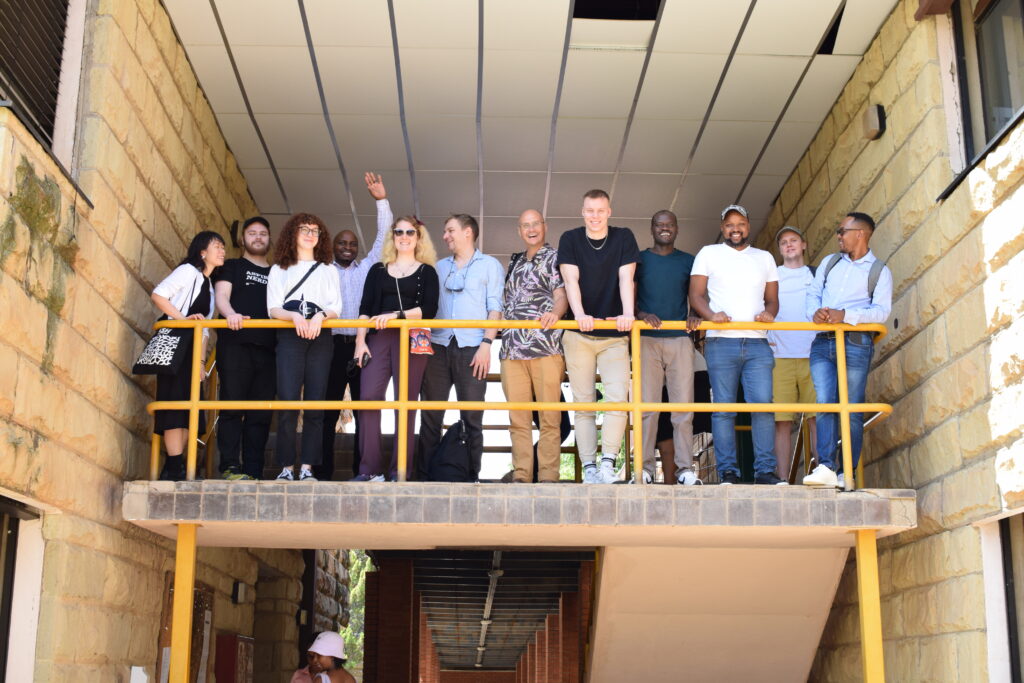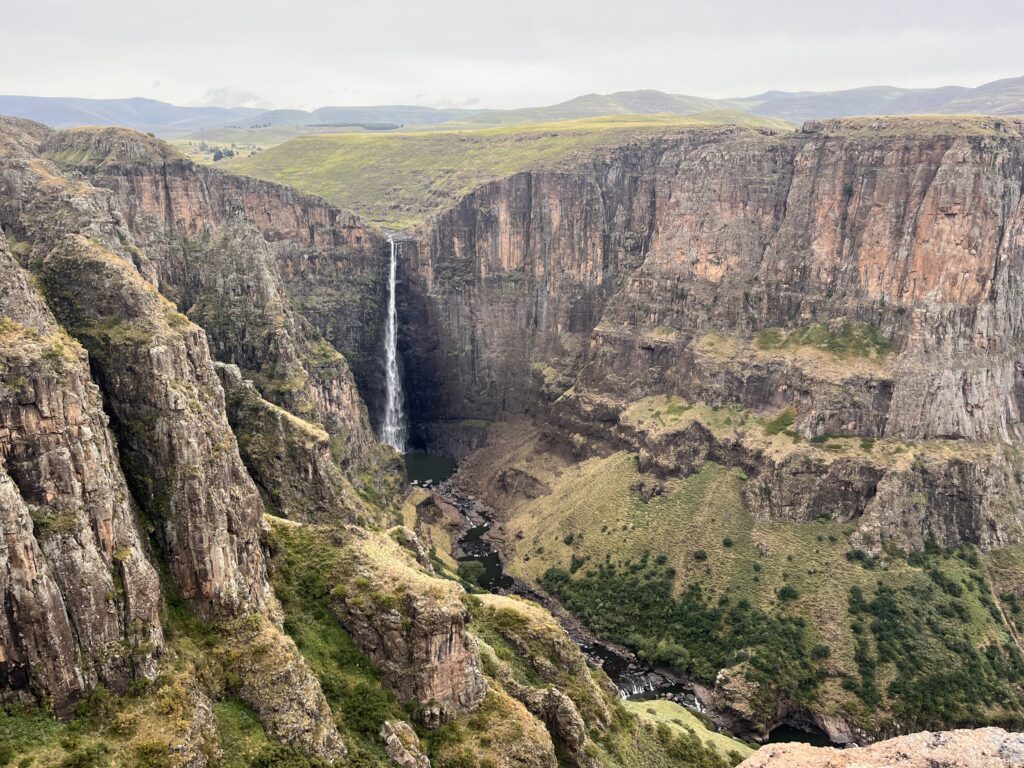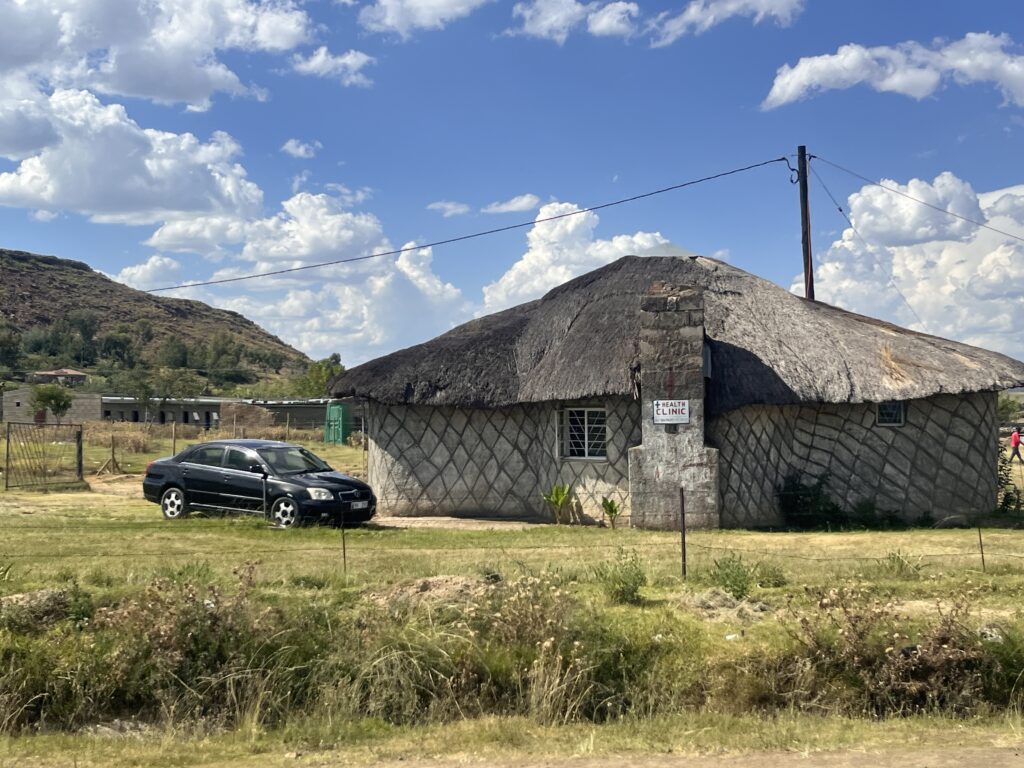By: Jimi Bäck, Tuomas Haapala, Jennifer Schurr, Dorottya Füleki, Yu Ching Sun & Simbarashe Nhokovedzo
Lesotho, known as the Kingdom in the Sky because its entire territory lies over 1000 meters above sea level, is where electricity is a rare luxury. Energy poverty concerns nearly half the population of this tiny country in Southern Africa, leaving them with little or no access to energy during their everyday lives. Many rural communities in Lesotho are disconnected from the national electricity grid, leaving most residents without electricity. Some are forced to rely on expensive unsustainable alternatives like oil boilers to access electricity.
Surrounded by beautiful mountains and valleys, we spent two weeks learning and discussing energy issues in Lesotho. We are six students from Aalto University and the University of Turku in Finland, including members from Finland, Germany, Hungary, Hong Kong, and Zimbabwe, with studies in energy, water, sustainability, future studies, and urban planning. This trip was facilitated by Aalto’s Sustainable Global Technologies (SGT) programme, which offers various projects addressing different global issues. Our goal with our project was to uncover the issues related to electricity access for rural communities in Lesotho and to identify the actions needed to resolve these issues. We were supported by DEPLOY, a project focused on developing sustainable energy education in Lesotho. Additionally, the project aims to strengthen partnerships with various stakeholders like the National University of Lesotho to spread knowledge more effectively.

Students and staff from Aalto University, University of Turku, and National University of Lesotho during an intensive course at the National University of Lesotho in the first week of the field visit.
People and nature in Lesotho – Lesotho is a southern African country famous for its strong mountain ranges, which have helped shape its unique cultural and political independence. With Maseru as its capital, Lesotho is one of the world’s most homogeneous nations, primarily composed of the Basotho people. They use their traditional language, Sesotho, along with English as their official languages. The country faces its unique challenges, such as one of the highest HIV/AIDS rates worldwide, while striving for progress in education and literacy. The nation’s history of frequent political changes shows the resilience of its people, who continue to work toward modernization and sustainable development.
During our time in Lesotho, we had the opportunity to visit several iconic places, each rich in history and natural beauty. One of the highlights was Thaba Bosiu, a historic mountain known as the Mountain at Night. It served as a fortress for King Moshoeshoe I during the 19th century and is regarded as the birthplace of the Basotho nation. The name reflects the belief that the mountain grew larger at night, providing greater protection against enemies. Steep cliffs surround the mountain and offer wide views of the surrounding area, making it a powerful symbol of Lesotho’s lasting heritage.
We also visited the Kome Caves, a remarkable place where ancient homes made of clay are located under a mountain. These caves were originally built in the 19th century by the Basotho people as a refuge from invading tribes and harsh weather. Today, they stand as a testament to the cleverness and resilience of Lesotho’s ancestors. Tucked beneath the mountain, the caves offered excellent cover and a cool shelter, helping the Basotho people stay hidden from invaders and comfortable in the heat. As we entered the small homes, we could feel the cool air on our skin, which offered a refreshment from the hot, sunny day.
Additionally, we explored Maletsunyane Falls, one of Africa’s tallest single-drop waterfalls. Falling about 192 meters into a deep valley, the powerful Falls is surrounded by steep cliffs and green vegetation, creating a stunning view. Getting to the falls required a scenic hike, which let us fully enjoy the calm and nearly untouched natural surroundings. Seeing locals passing by with horses on our way to the waterfall was amazing, with each rider wearing Lesotho’s national straw hat, the Mokorotlo.
Visiting these iconic locations was crucial for our project as it allowed us to fully experience Lesotho’s rich culture and understand the landscape more deeply. By experiencing the historical significance of places like Thaba Bosiu and the Kome Caves, we gained a greater appreciation for the resilience and cleverness of the Basotho people. Exploring the natural beauty of Maletsunyane Falls and the surrounding areas provided us with a better understanding of the local environment and its potential for sustainable energy solutions. These visits helped us to connect with the community on a deeper level, fostering a sense of respect and collaboration that is essential for the success of our project.

Maletsunyane Falls. Due to a dry year, the waterfall was less powerful than usual. Under normal conditions, it would have been even more spectacular.
The Benefits of Expanding Electricity Access
Access to reliable electricity in rural Lesotho could serve as a catalyst for improving living conditions and significantly enhancing healthcare, education, personal safety, and economic development. In healthcare facilities, consistent electricity means more advanced and reliable medical equipment can be utilized, improving patient care, and expanding the range of treatments available in the community. During our time there, we only saw a small health clinic, which showed that the level of healthcare was lacking and could greatly benefit from improvements in electricity access.

Health Clinic in Lesotho
For education, it translates to well-lit classrooms and access to electronic learning tools that can extend educational opportunities. During the first week of our visit, we participated in an intensive course on sustainable energy at the National University of Lesotho, which allowed us to observe the educational environment. The university had access to electricity, which significantly enhanced the standard of teaching and highlighted their commitment to improving education. However, the difference with rural areas was clear. The lack of electricity access there makes it hard to use essential educational tools like computers, which are common at the university. This creates a significant educational gap that could hinder the progression of students from these rural areas.
Safety could be increased with the implementation of streetlights, reducing crime and accidents. During our visit, we observed that the streets were extremely dark at night, with almost no street lighting. This made the traffic dangerous, and locals shared that accidents are very common. The roads, also used for walking, become particularly dangerous in the darkness with cars passing close by. Despite these conditions, we always felt safe thanks to the locals who were incredibly helpful and accompanied us, guiding us through their community. Nevertheless, we were advised not to walk alone at night and to remain cautious of the potential dangers.
Economic opportunities expand beyond traditional agriculture, as electricity allows for the operation of diverse businesses. It also adds value to agricultural products, creating new job opportunities and boosting the local economy. Reliable electricity is thus not just a utility but a transformative force for better living standards and opportunities. During our visit, we saw how access to electricity had already created new job opportunities for locals. For example, there were supermarkets with refrigerators, as well as barbershops using electric clippers, all thriving in areas with electricity access.
The Challenges of Expanding Electricity Access
While our project with the SGT programme strives to make a positive impact, we face substantial challenges that hinder progress. Lesotho holds considerable knowledge about sustainable energy within its borders. However, this expertise is unevenly distributed, with some rural areas having only a limited understanding of the topic. This gap in knowledge sharing across the country creates a significant obstacle to the widespread adoption of sustainable energy practices. Because of this knowledge gap, we found that people in rural areas are often unaware of how electricity access could improve their lives. They also do not know if it is even possible to obtain some form of electricity supply for their communities. Additionally, superstitions such as the belief that water released by dams can cause blindness and that electricity cannot travel uphill further contribute to the hesitation to adopt these technologies. As a result, they are not actively demanding electricity access or making efforts to secure it, which further slows progress in expanding electricity access in rural communities.
We visited a mini-grid site in Semonkong village, which is located near Maletsunyane Falls. The village was supposed to be connected to a hydroelectric plant to supply electricity to the community. However, during our visit, we discovered that the hydropower system was not operational due to the dry season and a problem with the turbine. As a result, the village had to rely on an oil boiler to meet its electricity needs. This situation highlighted the challenges and vulnerabilities associated with relying on single sources of energy and underscored the importance of developing robust and diversified sustainable energy solutions. It also emphasized the need for local expertise to fix issues like the turbine, which had been out of operation for a while.
Additionally, we were invited to visit a place called The Hub, run by a Finnish woman we met during our visit. The Hub is a community center where children are taught about sustainability, indirectly reaching the older generations. During our time there, we were warmly welcomed and even given Sesotho names by the children, which made our visit particularly memorable. We had the chance to talk to the kids more closely, learning about their lives and aspirations. We were also treated to fresh mangos from trees that the children had grown themselves, which was a delightful experience. This initiative at The Hub is a shining example of community efforts to promote sustainable practices. However, it serves just one small community, and there is a pressing need for more similar initiatives across the country to ensure broader and more impactful change.
On a global scale, there is a major lack of awareness about Lesotho’s energy challenges, which results in a shortage of international support and collaboration that could otherwise be gathered to help these communities. Financially, implementing sustainable energy solutions such as mini-grids and solar systems is very expensive, and Lesotho faces significant difficulties in acquiring the necessary funds. Mini-grids are small-scale electricity networks that could operate independently of the national electricity grid, making them suitable for rural communities located far from the main grid. Solar systems can serve various purposes, such as lighting, space and water heating, and cooking, providing individual solutions for households. This lack of funds for these solutions is further complicated by a critical need for skilled professionals capable of installing and maintaining these systems to ensure longevity and efficiency.
Practical Guide to Improve Electricity Access
In our efforts to support the communities of Lesotho, we have developed a practical guide to help students engage with rural populations on sustainable energy solutions. The guide provides relevant considerations and steps for implementing sustainable energy solutions in Lesotho, especially focusing on areas beyond the national electricity grid. Its purpose is to help students consider their options and mark their progress in implementing energy solutions, ultimately increasing access to reliable and affordable electricity to improve the quality of life and economic opportunities in rural Lesotho.
The guide covers various sustainable energy alternatives such as solar, wind, and hydro, leveraging Lesotho’s natural conditions of high sunlight hours, suitable terrain for wind, and water flow. It also addresses the importance of system maintenance, community involvement, and economic consideration for sustainable energy management. This guide serves as a document for students at the National University of Lesotho to help them keep track of their conceptualization and implementation processes as well as reminding them of relevant conditions and community aspects to consider.
During our visit, we observed that the university staff and students were closely connected to rural communities and worked collaboratively with them. Close working relationships like this are why we believe sustainable energy development will be highly effective. Further course sessions and new projects in the Lesotho countryside will streamline the energy solution development process, making it more efficient and structured. This will facilitate easier future engagements with these communities, allowing for effective co-creation of solutions. We were continually told how crucial it is to work with the communities, understand their needs, and not just provide fixed solutions.
Takeaways
Reflecting on our work in Lesotho, we have seen up close the tenacity and creativity with which the local people approach energy challenges. For example, they were using more efficient stoves, which are better than open fires for cooking, to reduce fuel consumption and improve air quality. Moreover, they are exploring ways to harness solar energy for various uses, including direct solar radiation for cooking and water heating, as well as solar panels for generating electricity for lighting and even solar-powered mosquito traps. While these solutions are not yet widely used, there is significant interest and potential for their adoption. Their efforts drive change and innovation, much like the DEPLOY project, which leads to collaborative solutions in sustainable energy. We hope our insights start further conversation and action, inviting more initiatives that drive us toward a global commitment to enhanced electricity access in rural Lesotho.
As the DEPLOY project comes to an end, we want to inform you about the positive changes happening in Lesotho and the ongoing efforts to support sustainable energy development. Fortunately, this does not mean the end of all collaboration. A new project called LETSEMA, supported by the Erasmus+ program, aims to enhance the skills and capacity of Lesotho’s workforce through vocational education and training, improving employability in green and circular economies. We had the opportunity to join the kick-off of this project in Maseru, which included representatives from the LETSEMA project and various stakeholders from government, academia, and civil society. Projects like LETSEMA, alongside DEPLOY, show a comprehensive approach to helping communities, sharing knowledge, and encouraging international collaboration for a brighter, self-sustaining future in Lesotho.

